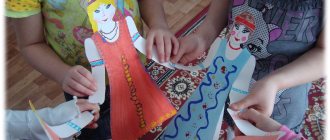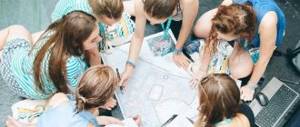Development of creative abilities of children with disabilities
Natalia Osipova
Development of creative abilities of children with disabilities
Creativity plays a huge role in a person’s life, and even more so for children with disabilities. It is easier for such children to express their feelings, experiences and emotions using visual images than verbally.
In the process of creativity , a child with needs gains a stronger sense of his own personal value, a sense of internal control and order arises, and individual social contacts are actively built. Averina N.L. recommends using the development of creative abilities of children with disabilities and children with disabilities through the use of fine arts.
In addition, some children with disabilities are limited or completely deprived of the ability to speak or hear, then the only tool that reveals and clarifies intense feelings and emotions is non-verbal means.
Creative also help children cope with negative experiences and internal difficulties that seem insurmountable for the child. If a child is indecisive, fearful, shy, creative activity ; regardless of the plot, it allows the child to get out of a state of constriction.
For children with disabilities , the development of creative abilities is very important, as it promotes self-realization , participation in creativity and creation , and the acquisition of experience of success in a specific area due to their abilities and hard work . A child with disabilities, participating in creative activities , can go from interest, through the acquisition of specific skills, to professional self-determination, which is also important for successful socialization.
For the development of creative abilities in children with disabilities, great potential lies in visual and decorative activities, the use of non-traditional techniques (stained glass, button collage, drawing with plasticine, candle; papier-mâché, combined appliqué).
All of these listed techniques attract with their artistic expressiveness and activate the individual abilities of children .
When working with children, we try to find contact with them. This is facilitated by a soft speech tone , bright visual materials, and a playful moment (showing a puppet theater character)
depending on the age of the child.
children's skills and abilities : the ability to use a pencil, felt-tip pen, the ability to draw vertical and horizontal lines, draw an oval, a circle. In subsequent classes, we try to find out the artistic talent of children through various games:
o cut pictures (first make a whole one from 2-3 parts, then increase the number of parts);
o story pictures (arrange 3–4 pictures in order)
;
series “Complete the picture”
(
“What did the kitten see?”
);
series “Loto”
(
“what does a cook or doctor need to work?”
).
We build classes from 4–5 parts:
1. Emotional mood (you can use a game, puppet theater characters, episodes from fairy tales with drawn characters). If a child is in a bad mood and is irritated, we use the following technique: we place a large sheet of green or yellow paper in front of him, we place 2-3 objects of the same color in the room, and the child is asked to find these objects.
2. Reading a poem or looking at illustrations on the topic of the lesson, showing a sample.
3. Finger gymnastics.
4. Explanation of the task.
5. Direct work.
The specifics of the classes are determined by their characteristics: the speed of onset of fatigue, dullness of the reaction to the instructions of an adult. Therefore, for correctional purposes, we use parts of the work, alternating explanations with doing the work. Switching types of activities increases efficiency and normalizes the pace of work. Alternating explanations with doing work also solves correctional and educational goals: developing endurance, inclusion in activity, its pace. We definitely include finger exercises, the use of which is most conducive to the development of productive activity and is very popular with children. Finger games are very exciting. We play with our fingers - we develop speech and creative activity . Children are happy to repeat movements and develop fine motor skills . This is how you develop the ability to control your movements and coordinate your attention.
When working with children with disabilities, the emotional attitude plays a special role. Positive emotions form the basis of children's , so we try to constantly support the child's interest in visual arts . Children feel the need not only for knowledge, but also for mastering skills, abilities, and methods of activity .
Two directions can be distinguished that satisfy the curiosity of the little artist, and at the same time do not require technical virtuosity from him. These are playing with paints and working with different materials. T. S. Komarova o. "Learning"
begins with the formation of a motive -
“I want and should do this, I want it because it’s interesting to me
.
In our work with children with disabilities, we have chosen non-traditional methods of drawing , new types of materials, which allows us to develop fantasy , imagination and creativity , as they are especially interesting for children . The new material is presented as exciting, playful, like a fairy tale or story, with activity in mind. Various actions with paints, materials, and unusual techniques help children overcome their fear of a clean face, help satisfy their curiosity and overcome the fear of appearing misunderstood and funny. Drawing with unusual materials and original techniques allows children to feel bright positive emotions.
By developing creative abilities in children with disabilities , we create conditions for successful adaptation in society and equal opportunities for further existence in it.
The result is very effective and almost does not depend on skill and ability . Unconventional techniques and various materials are quite simple and resemble a game. Will children be interested to know that you can draw even on water, as well as with your fingers and palm? The printing technique allows you to depict the same object many times, creating different compositions. Tamponing is a completely exciting activity when you need to draw something light and airy: you touch the paper with a tampon and it turns out to be a cloud or a dandelion. Monotype, blotography, drawing with a candle, colored threads - all these techniques contribute to the development of imagination , attention, development of hand motor skills and hand-eye coordination. The unusual nature of drawing helps develop cognitive activity, the desire to experiment, and most importantly, correct their mental processes, because what is important for a child is the result that causes him joy, amazement, and surprise.
In our work we use integrated types of classes. (We suggest decorating the painted Christmas tree with multi-colored balls cut out of paper; Santa Claus - beard, hat, cotton wool trim on the suit). The use of ICT helps in work (we review slides on the topic of the lesson, presentation)
.
The development of creative abilities is important for children Promotes the discovery of personal potential, self-realization, and the acquisition of successful experience in a specific field through one’s abilities and hard work . A child with disabilities, participating in creative activities , can go from interest, through the acquisition of specific skills, to professional self-determination, which is also important for successful socialization. By developing creative abilities , we create conditions for successful adaptation in society.
Bibliography:
1. Grigorieva G. G. Development of a preschooler in visual arts / G. G. Grigorieva - M.: Academy, 1999.
2. Komarova T. S. Fine art of children in kindergarten and school. Continuity in the work of kindergarten and primary school / T. S. Komarova, O. Yu. Zyryanova - M.: Pedagogical Society of Russia, 2000.
Creative development of children with disabilities as a means of socialization in a general education school
,
Deputy Director for VVVR,
MBOU secondary school No. 18 named after,
Surgut, Tyumen region, Khanty-Mansi Autonomous Okrug - Yugra
Creative development of children with disabilities as a means of socialization in a general education school
| It is known that the leading role in development of the child's personality belongs to the emotional sphere. () |
Abstract: Since the traditional education system ceases to meet modern requirements and fulfill the social order of society. Currently, there is a need to change the priorities of the traditional school towards creating opportunities for self-realization and the development of creative individuality. This can fully apply to children with disabilities.
Keywords:
OVZ - Children with disabilities;
Inclusive education - (French inclusif - including, Latin include - I conclude, include, involve) - one of the processes of transformation of general education, based on the understanding that people with disabilities in modern society can (and should) be involved in society.
Psychological and pedagogical rehabilitation is a system of psychological and pedagogical activities aimed at developing ways of mastering knowledge, skills and abilities, providing psychological assistance, in particular regarding the formation of self-affirmation and proper self-esteem by a person of their capabilities, mastering the rules of social behavior through the implementation of systematic educational work . Changes associated with scientific and technological progress have caused a rapid change in technology. At the present stage, there is a need to quickly master new technologies and integrate them into any emerging situation. In a rapidly changing world, society much more often rethinks the order of the school and changes the goals and objectives of school education. Approaches associated with purely mechanical accumulation and reproduction of information are no longer justified. With the reproductive method of assimilation of information, society no longer needs obedient performers - it needs creative people.
The National Strategy of Action in the Interests of Children for 2012-2017, approved by Decree of the President of the Russian Federation of June 1, 2012 No. 000, defines principles, one of which is the maximum realization of the potential of each child. Based on the Convention on the Rights of the Child and the Law on Education, state policy has set a course for the integration of children with disabilities (disabilities) into general education institutions. The modern concept of education and upbringing also includes, as an important element, the problem of nurturing the creative personality of each child. The problem of creativity has always aroused interest among scientists and researchers. “Creativity is the lot of everyone, ... it is a normal and constant companion of child development” (). Creative activity is individual. And its formation and development is an urgent problem in the theory and practice of raising and teaching children.
Currently, as part of the development of inclusive education, there is a need in secondary schools to organize comprehensive work with children with disabilities (hereinafter, HIA).
In particular, a very important area of work is related to providing the necessary conditions that will allow this category of children to successfully socialize in a modern society of healthy people.
When solving this problem, it is necessary to be guided by the following characteristics of children with disabilities: this category of children often shows a tendency to be isolated from society. Previously, this was facilitated by separate upbringing from healthy children in special schools and institutions. Although the situation has now changed, disabled children still exhibit a violation of their ability to participate in the normal process of life. Deviations in the mental development of disabled children cause, first of all, disturbances in the cognitive and communicative spheres, but can also lead to disturbances in their emotional and volitional sphere, which, in turn, can cause pathological forms of behavior and activity. A child with disabilities often exhibits such emotional states as feelings of fear, resentment, fear, shame, and in disabled children they often have an extreme degree of severity: from exaltation to complete dullness. Self-esteem in this category of children is also affected: according to numerous psychological studies, the majority of children with disabilities have low self-esteem: a significantly smaller proportion have adequate self-esteem, and inflated self-esteem is very rare. Also, it should be noted that a child with disabilities will be influenced by his immediate environment. After all, the attitude of the immediate environment either enhances the influence of the defect on the child’s personality and his development as a whole, or helps him compensate for this influence.
Therefore, based on the characteristics of children with disabilities, it is necessary to work on solving the following correctional problems:
● Improvement of the psyche: nurturing self-confidence, endurance, strong-willed character traits. Help each child feel their success, promote personal self-realization;
● Development of mental processes and properties;
● Strengthening, training the musculoskeletal system: developing balance, freedom of movement, relieving excess muscle tension, improving orientation in space, coordination of movements; breathing development; education of correct posture and gait; formation of motor skills and abilities; development of agility, strength, endurance.
● In case of speech disorders, development of the articulatory apparatus through special musical and rhythmic exercises, artistic creativity techniques to correct motor skills and speech.
1. Art is a unique means of shaping the most important aspects of mental life - the emotional sphere, imaginative thinking, artistic and creative abilities;
2. Art has great health-improving and developmental potential: for example, through the use of specially selected means and methods of aesthetic education, positive psychosomatic effects can be achieved;
3. Through art, the formation and development of a child’s personal qualities occurs. For example, in the process of musical, artistic-rhythmic and visual arts classes, a child can demonstrate those individual capabilities that do not find their expression during other classes within the framework of correctional and developmental education. Through regular artistic and aesthetic classes, children with disabilities develop such personal qualities as hard work, responsibility, perseverance, patience, a sense of mutual assistance, and a desire to overcome difficulties.
4. The complex impact on the cognitive and emotional-volitional sphere of a child with disabilities is aimed at development and self-development, the possibility of creative self-expression. Music and fine arts classes allow children with disabilities to develop aesthetic taste, visual and figurative thinking, creative imagination, memory, expand their cultural horizons, develop knowledge and skills in the creative field, and reveal children’s abilities.
5. Creative activities contribute to more successful adaptation of children with disabilities to life and the organization of social self-affirmation. For example, artistic classes allow children with disabilities to self-realize in an area accessible to them. A wide variety of formal and auxiliary techniques allows children to believe in themselves, creates a stable situation of success, which is the basis for developing an interest in creativity. Subsequently, music and art classes can become the future profession of children with disabilities.
Accompanying a child with disabilities systematizes work in the direction of creative rehabilitation of children with disabilities, orients adults (teachers, parents) to create conditions for activating the child’s aesthetic attitudes as an integral characteristic of his worldview and behavior.
Thus, the inclusion of children with disabilities in a creative environment will develop their creative abilities in the field of theater, music and visual arts, and communication skills.
Classes in additional education programs with artistic orientation will contribute to the further development of life competence in children with disabilities:
— a sufficient level of mastery of practical skills in educational and creative activities and interaction with others;
— expanding the horizons of children with disabilities about the world of art;
— successful socialization and adaptation of children with disabilities in society.





